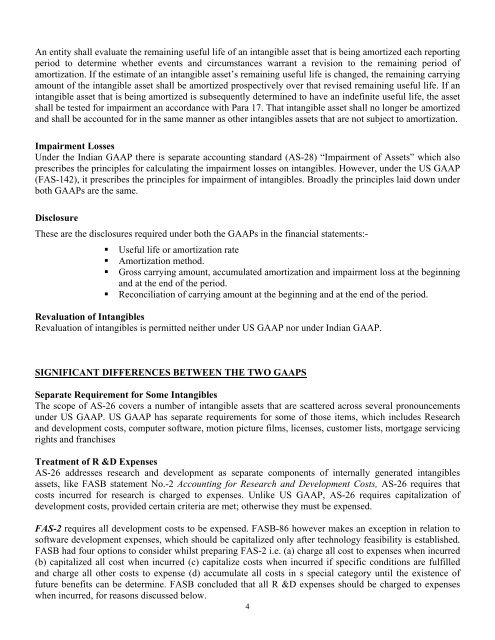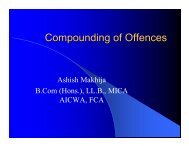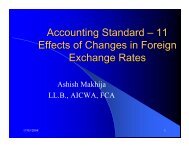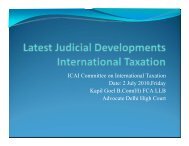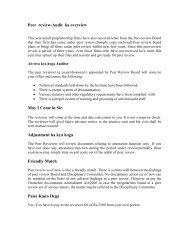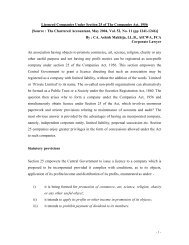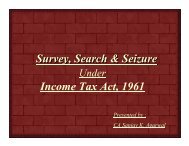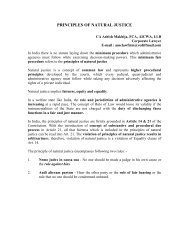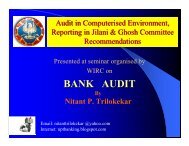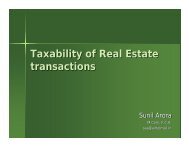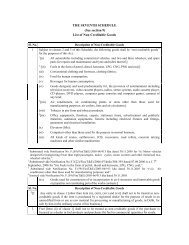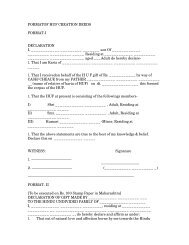dsrawat, fca intangible assets
dsrawat, fca intangible assets
dsrawat, fca intangible assets
Create successful ePaper yourself
Turn your PDF publications into a flip-book with our unique Google optimized e-Paper software.
An entity shall evaluate the remaining useful life of an <strong>intangible</strong> asset that is being amortized each reportingperiod to determine whether events and circumstances warrant a revision to the remaining period ofamortization. If the estimate of an <strong>intangible</strong> asset’s remaining useful life is changed, the remaining carryingamount of the <strong>intangible</strong> asset shall be amortized prospectively over that revised remaining useful life. If an<strong>intangible</strong> asset that is being amortized is subsequently determined to have an indefinite useful life, the <strong>assets</strong>hall be tested for impairment an accordance with Para 17. That <strong>intangible</strong> asset shall no longer be amortizedand shall be accounted for in the same manner as other <strong>intangible</strong>s <strong>assets</strong> that are not subject to amortization.Impairment LossesUnder the Indian GAAP there is separate accounting standard (AS-28) “Impairment of Assets” which alsoprescribes the principles for calculating the impairment losses on <strong>intangible</strong>s. However, under the US GAAP(FAS-142), it prescribes the principles for impairment of <strong>intangible</strong>s. Broadly the principles laid down underboth GAAPs are the same.DisclosureThese are the disclosures required under both the GAAPs in the financial statements:-• Useful life or amortization rate• Amortization method.• Gross carrying amount, accumulated amortization and impairment loss at the beginningand at the end of the period.• Reconciliation of carrying amount at the beginning and at the end of the period.Revaluation of IntangiblesRevaluation of <strong>intangible</strong>s is permitted neither under US GAAP nor under Indian GAAP.SIGNIFICANT DIFFERENCES BETWEEN THE TWO GAAPSSeparate Requirement for Some IntangiblesThe scope of AS-26 covers a number of <strong>intangible</strong> <strong>assets</strong> that are scattered across several pronouncementsunder US GAAP. US GAAP has separate requirements for some of those items, which includes Researchand development costs, computer software, motion picture films, licenses, customer lists, mortgage servicingrights and franchisesTreatment of R &D ExpensesAS-26 addresses research and development as separate components of internally generated <strong>intangible</strong>s<strong>assets</strong>, like FASB statement No.-2 Accounting for Research and Development Costs, AS-26 requires thatcosts incurred for research is charged to expenses. Unlike US GAAP, AS-26 requires capitalization ofdevelopment costs, provided certain criteria are met; otherwise they must be expensed.FAS-2 requires all development costs to be expensed. FASB-86 however makes an exception in relation tosoftware development expenses, which should be capitalized only after technology feasibility is established.FASB had four options to consider whilst preparing FAS-2 i.e. (a) charge all cost to expenses when incurred(b) capitalized all cost when incurred (c) capitalize costs when incurred if specific conditions are fulfilledand charge all other costs to expense (d) accumulate all costs in s special category until the existence offuture benefits can be determine. FASB concluded that all R &D expenses should be charged to expenseswhen incurred, for reasons discussed below.4


